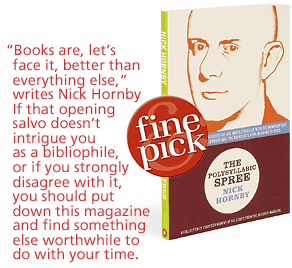| |
 |
 |
 |
The Polysyllabic Spree
By Nick Hornby
 San Francisco: San Francisco: Believer Books, 2004
143 pages. $14.00
ISBN 1932416242
Books are, let’s
face it, better than everything else,” writes Nick Hornby. If that
opening salvo doesn’t intrigue you as a bibliophile, or if you
strongly disagree with it, you should put down this magazine and find
something else worthwhile to do with your time (canasta, perhaps), because
everything that follows in Hornby’s book, and in this review, is a
passionate
and opinionated dispatch about reading books. To wit: “If we played cultural Fantasy Boxing League, and made books go
fifteen rounds in the ring against the best that any other art form had to
offer, then books would win pretty much every time.
Go on, try it. ‘The Magic Flute’ v. Middlemarch? Middlemarch in six. ‘The Last Supper’ v. Crime and Punishment? Fyodor on points.…Every now and then you’d get a shock, because that happens in sport, so Back to the Future III might land a lucky punch on Rabbit, Run; but I’m still backing literature twenty-nine times out of thirty.” Hornby is the author of several novels—High Fidelity, About a Boy, etc.—that
have been surprising critical and commercial successes;
because they’re good literature and they’re entertaining. The
Polysyllabic Spree is a collection of
Hornby’s monthly columns for The Believer magazine. Opaquely titled “Stuff I’ve Been
Reading,” every column begins with two lists: “Books
Bought” and “Books Read.” Sometimes there’s overlap
between them, but more often, there are curious differences and gaping
holes. Hornby spends much of the column describing what he read and
how he read it. He also makes excuses for what he didn’t read:
didn’t have time; something else came up; he read another book not on
the list; the book was unreadable or boring, and he just
couldn’t finish it.
The lists reflect the divergent interests and
wandering attention span of the average booklover. In one month, he read
Gustave Flaubert’s letters; John Buchan’s 1916 espionage tale, Greenmantle; Michael
Lewis’s Wall Street memoir, Liar’s
Poker; and a self-help book, How to Stop Smoking. In another month,
he completely focused on a single whopper of a book, Charles
Dickens’s David Copperfield. “Where would David
Copper-field be if Dickens had gone to writing
classes?” he asks. “Probably about seventy minor
characters short is where.” His observations on Dickens are
acute (“In The Old Curiosity Shop
I discovered that in the character of Dick Swiveller,
Dickens provided P. G. Wodehouse with pretty much the whole of his
oeuvre.”), as are his insights on literature, publishing, music, and
politics. He’s particularly poignant while discussing George
and Sam, by Charlotte
Moore,
a book about Moore’s autistic son. Hornby relates to the
book and the author because one of his sons is also autistic and, he says,
there are few books like Moore’s that really capture
the
experience of living with an autistic child.
Personal life and cultural life are tightly wrapped in
Hornby’s writing. He admits his peculiarities, ignorance, and
prejudices up front. He dismisses one book (the title and author shall
remain mercifully nameless here) based on single snippet of dialogue:
“I am positive that no one has ever said ‘Arsenal won Liverpool
3-0’ in the entire history of either Arsenal Football Club
or the
English Language.
‘Beat,’ ‘thrashed,’
‘did’ or ‘done,’ ‘trounced,’
‘thumped,’ ‘shat all over,’ ‘walloped,’
etc., yes; ‘won,’ emphatically, no.” Hornby’s first
book, Fever Pitch,
was about soccer, so he knows what he’s talking about here.
These aren’t remotely conventional book reviews.
Hornby’s columns are like a literary reality show in print: Man tries
to read all the books he buys and write a monthly column on deadline,
while striving to maintain a career, a family, and a semblance of
a social life. He doesn’t crack before our eyes, but he does get
physical while reading Wilkie Collins’s No
Name. “We fought, Wilkie Collins and I.
We fought bitterly and with all our might, to a standstill, over a
period of about three weeks, on trains and airplanes and by hotel swimming
pools. Sometimes—usually late at night, in bed—he could put me
out with a single paragraph.”
The process of reading a book is actually work, Hornby
reminds us, subject to short attention spans, forgetfulness, personal
crises, family business, and other interruptions from life. Besieged on all
sides by books— some outstanding, most mediocre —the
professional reviewer must read them all the way through out of obligation. The Polysyllabic Spree is dear to me, as Fine Books & Collections’s book review editor, because
I see my own dilemma in these pages. I don’t need pity, and
neither does Hornby.
But Hornby does sometimes ask for forgiveness,
something I’ve never seen a book reviewer do. “Last
month,” he writes, “I may have inadvertently given you the
impression that No Name by Wilkie Collins was a lost Victorian classic (the
misunderstanding may have arisen because of my loose use of the phrase,
‘lost Victorian classic’) and that everyone should rush out and
buy it. I had read over two hundred pages when I gave you my considered
verdict; in fact, the last four hundred and eighteen pages nearly killed
me, and I wish I were speaking figuratively.… I’m sorry for the
bum steer, and readers of this column insane enough to have run down to
their nearest bookstore as a result of my advice should write to The Believer, enclosing a
receipt, and we will refund your $14.
It has to say No Name on the receipt,
though, because we weren’t born yesterday, and we’re not
stumping up for your Patricia Cornwell novels.”
If his reviewing gig doesn’t work out, Hornby
can always rely on his other job as a novelist, but I hope he perseveres.
I don’t want him to crack before I do.
The Design Legacy of George Salter
 By Thomas S. Hansen. Foreword by Milton Glaser. By Thomas S. Hansen. Foreword by Milton Glaser.
New York: Princeton Architectural Press, 2005
200 pages. $35 paper
ISBN: 156898491x
If you collect fiction
published in the United States during the middle years of the twentieth
century—by Thomas Mann, William Faulkner, Graham Greene, Ayn Rand,
William Styron, Franz Kafka, John Hersey, Hermann Hesse, John Dos Passos,
or quite literally hundreds of other lesser-known authors—you will be
familiar with the jacket art of George Salter. Salter (1897–1967) was
born in Germany and practiced design in Berlin until emigrating in 1934 to
the States, where he began designing books and jackets for American
publishers.
Trained in calligraphy and design, Salter was one of a
handful of designers, like W. A. Dwiggins, Jan Tschichold, and a few
others, who changed the look of American books from the 1920s to the 1960s.
Salter’s dramatic combinations of hand-drawn lettering and his own
imaginative renderings, based on his intuitive understanding
of the central idea or image of
a book, made for some of the most
distinctive book covers of the period.
Thomas Hansen, a professor of German
at Wellesley
College, has put together the first complete survey of Salter’s
life and work, and it’s both delightful to look through and a
concise, thorough, and semischolarly account of all of Salter’s work.
Hansen divides the short text portion (48 pages) into sections:
Salter’s “Berlin years,” his activities in the 1930s and 1940s
(“From Berlin to New York”), and a final section on his
“Designs of the 1950s and 1960s.” The bulk of the book is given
over to full-color reproductions of more than two hundred examples of
Salter’s best work. At the back of the book are appendixes listing
all of Salter’s designs for German publishers (1922–34) and
American book publishers (1934–67), as well as notes and an extensive
bibliography.
Hansen’s heroic dedication to filling in
the
gaps in Salter’s own records can be seen in the appendixes, where he
lists the nearly 1,000 commissions Salter completed for book jackets,
bindings, magazines, and record covers for an astounding array of clients
(about thirty-five in Germany and nearly a hundred in the U.S.), making
this something between a catalog raisonné and a comprehensive
bibliography.
|
|
|
|
